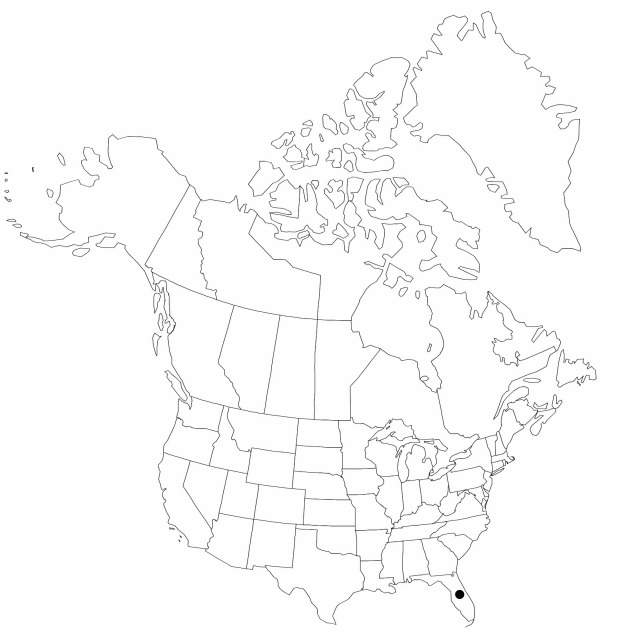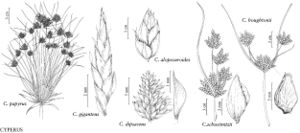Difference between revisions of "Cyperus alopecuroides"
Descr. Pl. Rar., 20. 1772.
FNA>Volume Importer |
imported>Volume Importer |
||
| (5 intermediate revisions by 2 users not shown) | |||
| Line 6: | Line 6: | ||
|place=20. 1772 | |place=20. 1772 | ||
|year=1772 | |year=1772 | ||
| + | }} | ||
| + | |special_status={{Treatment/ID/Special_status | ||
| + | |code=I | ||
| + | |label=Introduced | ||
| + | }}{{Treatment/ID/Special_status | ||
| + | |code=F | ||
| + | |label=Illustrated | ||
}} | }} | ||
|basionyms= | |basionyms= | ||
| Line 23: | Line 30: | ||
|elevation=0–30 m | |elevation=0–30 m | ||
|distribution=Fla.;West Indies;Asia;Africa;Australia. | |distribution=Fla.;West Indies;Asia;Africa;Australia. | ||
| + | |introduced=true | ||
|discussion=<p><i>Cyperus alopecuroides</i> has been introduced in Polk County, Florida.</p><!-- | |discussion=<p><i>Cyperus alopecuroides</i> has been introduced in Polk County, Florida.</p><!-- | ||
--><p>Plants of <i>Cyperus alopecuroides</i> might be confused with <i>C. digitatus</i>; large size and the biconvex achenes with two stigmas characterize <i>C. alopecuroides</i>.</p> | --><p>Plants of <i>Cyperus alopecuroides</i> might be confused with <i>C. digitatus</i>; large size and the biconvex achenes with two stigmas characterize <i>C. alopecuroides</i>.</p> | ||
| Line 33: | Line 41: | ||
-->{{#Taxon: | -->{{#Taxon: | ||
name=Cyperus alopecuroides | name=Cyperus alopecuroides | ||
| − | |||
|authority=Rottbøll | |authority=Rottbøll | ||
|rank=species | |rank=species | ||
| Line 48: | Line 55: | ||
|publication title=Descr. Pl. Rar., | |publication title=Descr. Pl. Rar., | ||
|publication year=1772 | |publication year=1772 | ||
| − | |special status= | + | |special status=Introduced;Illustrated |
| − | |source xml=https:// | + | |source xml=https://bitbucket.org/aafc-mbb/fna-data-curation/src/2e0870ddd59836b60bcf96646a41e87ea5a5943a/coarse_grained_fna_xml/V23/V23_289.xml |
|genus=Cyperus | |genus=Cyperus | ||
|subgenus=Cyperus subg. Cyperus | |subgenus=Cyperus subg. Cyperus | ||
Latest revision as of 20:39, 5 November 2020
Herbs, perennial, rhizomatous, coarse. Culms trigonous, 150–250 cm × 2–15 mm, glabrous. Leaves inversely W-shaped, 30–150 cm × 6–22 mm. Inflorescences: spikes 1–4, cylindric, 1.5–4 cm × 7–15 mm; rays 3–9, 10–26 cm; 2d order rays 2–11 cm; 3d order rays 1–4 cm (or absent); bracts 3–5, ± horizontal, 20–100 cm × 3–15 mm; 2d order bracts 2–7 cm × 2–7 mm; 3d order bracts 2–5 cm × 2–4 mm (or absent); rachilla persistent, wingless or wing hyaline, narrow, 0.1 mm wide. Spikelets 50–100, linear, ± quadrangular, slightly compressed, 8–11 × 0.9–1.2 mm; floral scales 15–30, marginally clear, laterally reddish along midrib, medially green, laterally 3–4 ribbed, medially 3–5-ribbed, ovate, 1–2–1.6 × 1.1–1.3 mm, apex mucronulate. Flowers: anthers 2, 0.4–0.5 mm; styles 0.8–1 mm; stigmas 2, 0.4 mm. Achenes dark brown, sessile, ellipsoid to obovoid, 0.9 × 0.4–0.5 mm, surfaces finely puncticulate.
Phenology: Fruiting summer.
Habitat: Pond shores, stream banks
Elevation: 0–30 m
Distribution

Introduced; Fla., West Indies, Asia, Africa, Australia.
Discussion
Cyperus alopecuroides has been introduced in Polk County, Florida.
Plants of Cyperus alopecuroides might be confused with C. digitatus; large size and the biconvex achenes with two stigmas characterize C. alopecuroides.
Selected References
None.
